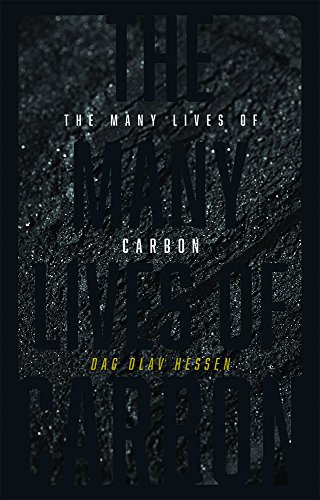The Many Lives of Carbon
Dag Olav Hessen

A good overall survey, struggling a little bit in translation.
As participants in the carbon cycle we all have a share in eternity.
Thanks to his unusual combination of precision and patience, Keeling, much to his dismay, was able to confirm that CO2 concentrations were rising year after year.
Carbon accounts for less than five parts per thousand of the universe’s total elemental mass, yet is nonetheless the fourth most common element.
The much later Cretaceous Period, derived from Latin creta for ‘chalk’, which lasted from 145 to 65 million years before our present era, is also characterized by its carbon deposits, although in the form of calcium carbonate, CaCO3
Sitting at the campfire, ideally with a view, ideally with something at one’s back, and most ideally next to water, is a ritual almost imprinted in our genes.
The oldest known graphite also perhaps provides evidence of the oldest known planetary life. This graphite is found in a deposit of 3.8 billion- year- old sedimentary rock in Greenland, and is so pure you can write with it. It contains the isotope 13C (to which we will return), which strongly suggests a biological origin,
Without the greenhouse effect of CO2 (not to mention water vapour, methane and nitrous oxide), earth’s average temperature would be –20°C instead of the present ideal state of +15°C. I
Carbon and oxygen, of course, are both central to photosynthesis, life’s most important reaction, not to mention hydrogen, which is a fundamental element in every sense. These three elements form endless relationships and reactions, but the most important one looks like this: 6CO2 + 12H2O + energy → C6H12O6 + 6O2 + 6H2O
The stoichiometric equation for a human being, which takes into account the body’s water content, will look like this for the most important elements: H375 000 000 O132 000 000 C85 700 000 N6 430 000 Ca1 500 000 P1 020 000 S206 000 Na183 000 K177 000 Cl127 000 Mg40 000 Si38 600 Fe2 680 Zn2 110 Cu76 I14 Mn13 F13 Cr7 Se4 Mo3 Co148
It is always amusing to remember that there are ten times more bacterial cells present in and on a person than our own cells
On a very long time horizon, on a 100,000-year timescale, CO2 will be sequestered by mountain weathering.
In short, Arrhenius, who was an impressive visionary, managed to outline in a few pages the central insights into the carbon cycle, while also citing emissions from fossil energy sources as having a potential impact on the climate.
Although today storing fat does not seem so wise, lean times can always come again, which will return the strategy to its dignity and honour.
It is always worth remembering that although the ocean’s microscopic plants, despite their veritable number, comprise no more than 10 per cent of the earth’s total plant biomass, still they are responsible for half the photosynthesis and carbon-binding that occurs.
The boreal coniferous forest comprises a third of the world’s forests, but sequesters almost 60 per cent of the world’s carbon.
In principle, every petrochemical product can be retrieved from the forest; the timber industry often claims it can deliver everything the oil industry delivers, and if trees can provide fuel in addition to managing CO2 emissions through photosynthesis, it is difficult to get any cleaner and better.
It is estimated that every phosphorus atom is recycled fifty times on average before it vanishes from the system.
‘Peak phosphorus’ is approaching and will be a much greater challenge than ‘peak oil’, but to the human brain a hundred years from now still seems far away.
It is entirely possible we could cut our personal CO2e footprint in half without feeling notably deprived. An increased sense of freedom and improved quality of life might even be a bonus. As we know, the best things in life are free.
Instead of a legislated CO2e quota we can envision a moral one